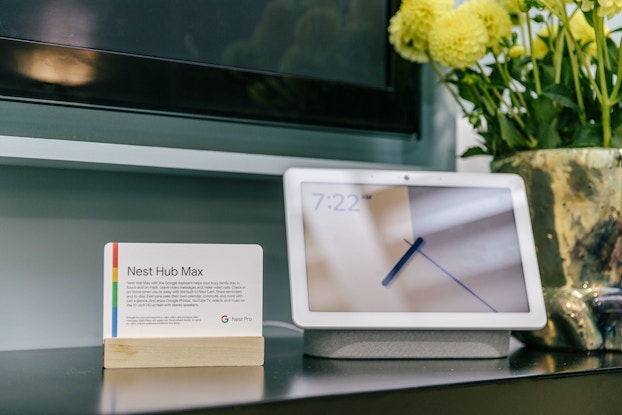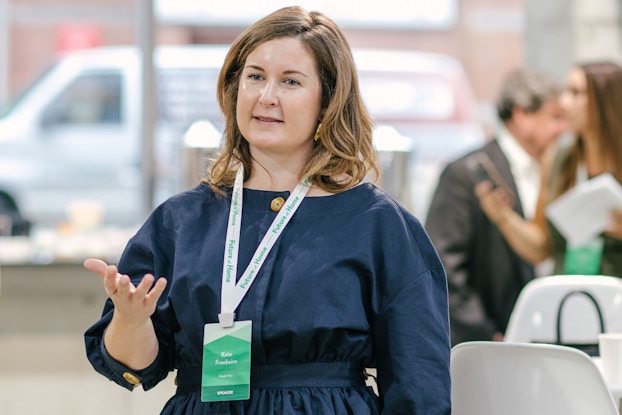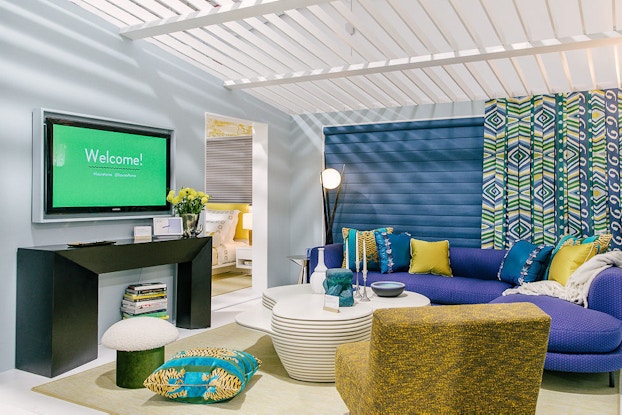
Google Nest, the company largely responsible for driving the smart home trend, with its Wi-Fi-connected thermostats, doorbell cameras and smoke detectors, wants to change the smart home discussion.
Instead of talking about the smart home, Google Nest likes to talk about the human home and the helpful home, director of user experience Kate Freebairn told CO—.
When designing products like the home assistant Google Nest Hub Max, which debuted in September, the company focuses on what connects people. The Nest Hub Max marks the evolution of Google’s home assistant, adding visual recognition to voice recognition, to help strengthen those human connections, she said.
“The way we like to put it, is [that] it brings the Google Assistant to life,” Freebairn told CO—. “Because for us as humans, hearing things means a lot, but when we look at each other, facial expressions also mean a lot.”
On the day Google Nest released the Max, Freebairn was at the Business of Home’s Future of Home conference in New York City talking about how technology, human connections and good design can coexist.
“We look at the helpful home as human, approachable, as something that really respects the home and the intimacy and the privacy and the sacredness,” Freebairn told the design and home industry professionals at the conference. “It’s not just about technology; it’s about fulfilling human needs.”
We look at the helpful home as human, approachable, as something that really respects the home and the intimacy and the privacy and the sacredness.
Kate Freebairn, director of user experience, Nest
Create value
Nest creates helpful homes that make their customers' lives easier. Read on for more customer convenience trends.
The next step for Nest
The Nest Hub Max can identify different users through facial recognition. Family members can get reminder alerts specific to them when the screen recognizes their faces. If a user holds up his or her hand in a stop gesture, the screen responds and pauses the music. Another hand gesture restarts it.
Designing devices such as the Nest Hub Max, which is intended to be used by multiple persons in a home, presents a different set of challenges than designing voice assistants or apps for a mobile phone used by one person, Freebairn told CO—.
“When designing for the home you have the question of what is personal information in a communal space,” she said. With facial recognition, the Max can remind one family member to buy a surprise birthday gift for another member, while keeping it a secret from that member.

Smart or intimidating?
Freebairn told the Future of Home attendees that Google Nest users are less concerned about how smart their home is, and more concerned about convenience and comfort.
“Consumers aren’t necessarily asking for smart homes. That’s not a core human need,” she said at the conference. But they are asking for homes and devices that make life easier, such as a home assistant that wakes you up with your favorite music, or opens the blinds for you, or sends an alert to your phone when the smoke detector needs new batteries, she said.
Smart home can be an intimidating term for consumers, she said.
“Smart home can imply ‘Oh that’s not me. That’s some technical person who knows how to set up all of these crazy things in their home.’”
A PricewaterhouseCoopers (PwC) study found that consumers often feel that smart home devices are “invasive” and “far too complex.”
PwC reported that one in four U.S. internet users owned a smart device at the time of the 2017 study, but it noted that most are not ready to make the leap to a fully connected home.
“There is a significant difference between consumers adopting individual devices (e.g. a smart thermostat) and consumers signing up for and/or graduating to a connected life,” the study concluded.
Disrupting home products
Nest Labs was founded in 2010 and introduced its first product, a Wi-Fi-enabled smart thermostat, in 2011. Google acquired Nest in 2014 for $3.2 billion.
“Both Google and Nest have a lot in common, which is what brought the two companies together,” Freebairn told the Future of Home attendees. “When you look at what we did at Nest in the early days, it was really taking a lot of products in the home and reinventing them. Thermostats hadn’t been disrupted in a long time.”
The goal of the combined companies, Freebairn said, is to take the “smarts and incredible AI [artificial intelligence] and machine learning in Google" and bring all of that into the home by asking "how can we put those smarts in these products so they’re useful for people.”

Designing for the long term
The Google Nest design teams want the products to be beautiful as well as helpful, Freebairn told the design industry professionals she addressed.
“We get a lot of inspiration from nature, from looking at furniture, home textiles, home objects that tempt the eye,” she said.
When designing products intended for long-term use, such as thermostats or smoke detectors, the team is also looking for styling that will be timeless but also beautiful, she said.
The colors, materials and finishes group studied 157 samples of material to find the right neutral gray color it wanted for the Google Home Mini, Freebairn said.
The ultimate goal, Freebairn said, is to make products that blend into the home so well that the technology becomes invisible.
As technology becomes more prevalent, behaviors change, she said, but “the basic human needs of connecting with one another and being heard and being seen” remain. “That to me will always be the center of the home,” Freebairn said.
CO— aims to bring you inspiration from leading respected experts. However, before making any business decision, you should consult a professional who can advise you based on your individual situation.
CO—is committed to helping you start, run and grow your small business. Learn more about the benefits of small business membership in the U.S. Chamber of Commerce, here.







